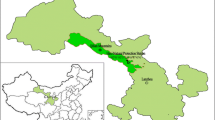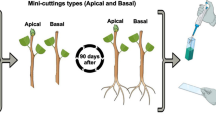Abstract
Chinquapin (Castanea henryi) is a dual-purpose tree species in China valued for as a source of timber and starch. We investigated the effect of four cutting mediums (pure vermiculite; peat:river sand at 3:1 v/v; peat:krasnozem at 1:1 v/v; and pure krasnozem) and three stem cutting periods (March, May, and July) on rooting performance of C. henryi cuttings. Different cutting periods and cutting mediums greatly influenced the rooting rate of C. henryi, ranging from 3.35 to 77.31%. Principal component analysis indicated that the best combination of cutting period and cutting medium was semi-hardwood cuttings (May cuttings) + krasnozem. Histological evidence indicated that adventitious root initials were present by week 5–6, and that the site of root primordia initiation was observed in the vascular cambium. Stem anatomical structures observed at different periods indicated that a xylem/radius ratio of 29.90–37.42% and a fractured phloem fiber ring are indicative of rooting success. The relational model between rooting index and medium properties indicated that nutrient content and porosity significantly influenced callus production. However, pH strongly affected C. henryi root formation, with the Pearson correlation coefficients for May and July cuttings of − 0.856 and − 0.947, respectively. Our protocol is helpful to achieve mass clone propagation of improved C. henryi genotypes, thus overcoming a common hurdle in chinquapin breeding programs.









Similar content being viewed by others
References
Aghdaei M, Nemati SH, Samiee L, Sharifi A (2019) Effect of rooting medium, cutting type and auxin on rooting of pepino (Solanum muricatum Aiton) cutting. Appl Ecol Environ Res 17:10357–10369
Agullo-Anton MA, Ferrandez-Ayela A, Fernandez-Garcia N, Nicolas C, AlbaceteA Perez-Alfocea F, Sanchez-Bravo J, Perez-Perez JM, Acosta M (2014) Early steps of adventitious rooting: morphology, hormonal profiling and carbohydrate turnover in carnation stem cuttings. Physiol Plant 150:446–462
Alexander H, Fahimeh S, Uwe D, Philipp F, Michael M, Twan R, von Wirén N, Mohammad-Reza H (2017) A specific role of iron in promoting meristematic cell division during adventitious root formation. J Exp Bot 68:4233–4247
Amissah JN, Paolillo DJ, Bassuk N (2008) Adventitious root formation in stem cuttings of Quercus bicolor and Quercus macrocarpa and its relationship to stem anatomy. J Am Soc Hortic Sci 133:479–486
Avidan B, Lavee S (1978) Physiological aspects of the rooting ability of olive cultivars. Acta Hortic 79:93–102
Chen WZ, He LB, Tian SY, Masabni J, Zhang RQ, Zou F, Yuan DY (2020) Combined addition of bovine bone and cow manure: rapid composting of chestnut burrs and production of a high-quality chestnut seedling substrate. Agronomy 10:288
Corredoira E, Martinez MT, Cernadas MJ, San Jose MC (2017) Application of biotechnology in the conservation of the genus Castanea. Forests 8:394
Denaxa NK, Roussos PA, Vemmos SN, Fasseas K (2019) Assessing the effect of oxidative enzymes and stem anatomy on adventitious rooting of Olea europaea (L.) leafy cuttings. Span J Agric Res 17:e0803
Druege U, Franken P, Hajirezaei MR (2016) Plant hormone homeostasis, signaling, and function during adventitious root formation in cuttings. Front Plant Sci 7:381
Du CJ, Sun JC, Chen W, Ji J, Jang ZP, Shi SQ (2019) Comparison of physiological and anatomical characteristics between seedlings and graftings derived from old Platycladus orientalis. Sci Silva Sin 55:41–49
Eskandari S, Sharifnabi B (2020) Foliar spray time affects the efficacy of applied manganese on enhancing cucumber resistance to Podosphaera fuliginea. Sci Hortic 261:108780
Fallik E, Alkalai-Tuvia S, Chalupowicz D, Popovsky-Sarid S, Zaaroor-Presman M (2019) Relationships between rootstock–scion combinations and growing regions on watermelon fruit quality. Agronomy 9:536
Fan XM, Yuan DY, Tang J, Tian XM, Zhang L, Zou F, Tan XF (2015) Sporogenesis and gametogenesis in Chinese chinquapin (Castanea henryi (Skam) Rehder & Wilson) and their systematic implications. Trees (Berl) 29:1713–1723
Gabriele B, Alberto A, Giancarlo B, José GL (2019) The chestnut handbook: crop and forest management, 1st edn. CRC Press, Boca Raton, pp 297–342
Gomes EN, Vieira LM, Tomasi JC, Tomazzoli MM, Grunennvaldt RL, Fagundes CM, Machado RCB (2018) Brown seaweed extract enhances rooting and roots growth on Passiflora actinia Hook stem cuttings. Ornam Hortic 24:269–276
He F, Chen H, Tang M (2019) Arbuscular Mycorrhizal Fungal communities are influenced by host tree species on the Loess Plateau, Northwest China. Forests 10:930
Jeffers SN, Meadows IM, James JB, Sisco PH (2012) Resistance to Phytophthora cinnamomi among seedlings from backcross families of hybrid American chestnut. In: Sniezko RA, Yanchuk AD, Kliejunas JT, Palmieri KM, Alexander JM, Frankel SJ tech. coords (eds) Proceedings of the fourth international workshop on the Genetics of host-parasite interactions in forestry: disease and insect resistance in forest trees. Gen. Tech. Rep. PSW-GTR-240. US Department of Agriculture, Forest Service, Pacific Southwest Research Station. Albany, pp 194–195
Kumar P, Jharia SK, Ansari SA (2011) Change in pH regimes and adventitious root induction in semi-hardwood cuttings of Gmelina arborea Roxb. Plant Growth Regul 65:531–536
Lee C, Paul J, Hackett WP (1976) Root promotion on stem cuttings of several ornamental plant species by acid or base pretreatment. Proc Int Plant Propag Soc 26:95–99
Legué V, Rigal A, Bhalerao RP (2014) Adventitious root formation in tree species: involvement of transcription factors. Physiol Plant 151:192–198
López-Villamor A, Míguez-Soto B, Fernández-López J (2017) Adventitious root formation in Castanea sp. semi-hard cuttings is under moderate genetic control caused mainly by non-additive genetic variance. Can J For Res 47:946–956
Lowe W, Beineke WF (1969) Comparing grafting techniques for black walnut. In: Proceedings of the 10th southern conference on forest tree improvement, pp 231–235
Maluf HJGM, Silva CA, de Morais EG, de Paula LHD (2018) Is composting a route to solubilize low-grade phosphate rocks and improve MAP-Based composts? Rev Bras Cienc Solo 42:1–17
Monder MJ, Kozakiewicz P, Jankowska A (2019) Anatomical structure changes in stem cuttings of rambler roses induced with plant origin preparations. Sci Hortic 255:242–254
Mukhtar RB (2019) Effect of rooting media and hormone concentrations on vegetative propagation of Balanites aegyptiaca. J For Res 30:73–76
Naija S, Nadhra E, Najoua J, Saida A, Kevers C (2008) Anatomical and biochemical changes during adventitious rooting of apple rootstocks MM 106 cultured in vitro. C R Biol 331:518–525
Perkins MT, Robinson AC, Cipollini ML, Craddock JH (2019) Identifying host resistance to Phytophthora cinnamomi in hybrid progeny of Castanea dentata and Castanea mollissima. HortScience 54:221–225
Porfirio S, da Silva MDRG, Cabrita MJ, Azadi P, Peixe A (2016) Reviewing current knowledge on olive (Olea europaea L.) adventitious root formation. Sci Hortic 198:207–226
Ride JP (1978) The role of cell wall in resistance to fungi. Ann Appl Biol 89:302–306
Rigling D, Prospero S (2018) Cryphonectria parasitica, the causal agent of chestnut blight: invasion history, population biology and disease control. Mol Plant Pathol 19:7–20
Stevens ME, Pijut PM (2017) Origin of adventitious roots in black walnut (Juglans nigra) softwood cuttings rooted under optimized conditions in a fog chamber. New For 48:685–697
Strzelecka K (2007) Anatomical structure and adventitious root formation in Rhododendron ponticum L. cuttings. Acta Sci Pol-Hortoru 6:15–22
Tetsumura T, Yamashita K (2004) Micro-propagation of Japanese chestnut (Castanea crenata Sieb. et Zucc.) seedlings. HortScience 39:1684–1687
Trofimuk LP, Kirillov PS, Egorov AA (2020) Application of biostimulants for vegetative propagation of endangered Abies gracilis. J For Res 31:1195–1199
Wang Y, Jia ZK, Ma LY, Deng SX, Zhu ZL, Shang ZY (2019) Effects of four plant growth regulators on rooting of the softwood cutting of Magnolia wufengensis. Sci Silva Sin 55:35–45
Wei H, Park JE, ParkYG Jeong BR (2019) A survey on the graft healing environment of commercial fruit vegetable plug seedling greenhouses in the Republic of Korea. Hortic Environ Biotechnol 60:329–336
Wen T, Li PB, Jiang SQ, Pu JF, Wang YM, Liu WX, Hua JP (2011) Study on cotton resistance to Verticillium wilt by grafting. Sci Agric Sin 44:5130–5136
Westbrook JW, James JB, Sisco PH, Frampton J, Lucas S, Jeffers SN (2019) Resistance to Phytophthora cinnamomi in American chestnut (Castanea dentata) backcross populations that descended from two Chinese chestnut (Castanea mollissima) sources of resistance. Plant Dis 103:1631–1641
Wróblewska K (2013) The influence of benzyladenine and naphthalene-1-acetic acid on rooting and growth of Fuchsia hybrida cuttings. Acta Sci Pol-Hortoru 12:101–113
Wu DP, Wu YF, Chen BX, Yang PQ, Liu ZH (2008) Developing status quo and countermeasures for main production area of Chinquapin in our country. Central South Forest Inventory and Planning 3:59–61
Xiong H, Sun H, Zou F, Fan XM, Niu GH, Yuan DY (2018) Micropropagation of Chinquapin (Castanea henryi) using axillary shoots and cotyledonary nodes. HortScience 53:1482–1486
Xiong H, Masabni J, Zou F, Yuan DY (2019) Castanea henryi roots serve as host for Ganoderma lucidum. Int J Agric Biol 22:420–426
Zhang M, Wang D, Tang HR, Ren SX, Liu RD (2010) Anatomical structure of stem and adventitious root formation of Feijoa cuttings. Sci Silva Sin 46:183–187+193
Zhang XF, Guo Y, Li Y, Zhang SH, Wang GP (2018) Research progress on chestnut seed rot. China Plant Prot 38:25–28+38
Zou F, Zhang XH, Yuan DY, Zhu ZJ, Tan LM, Liu DM (2019) The different pollination combinations in Castanea henryi determined by auto discrete analyzers and atomic absorption spectrometry. Spectrosc Spectr Anal 39:286–291
Author information
Authors and Affiliations
Corresponding authors
Additional information
Publisher's Note
Springer Nature remains neutral with regard to jurisdictional claims in published maps and institutional affiliations.
Project funding: This research was funded by the National Natural Science Foundation of China (Grant Nos. 31870674, 31500554) and the Natural Science Foundation of Hunan Province (Grant No. 2018JJ3870).
The online version is available at http://www.springerlink.com
Corresponding editor: Yu Lei.
Electronic supplementary material
Below is the link to the electronic supplementary material.
Rights and permissions
About this article
Cite this article
Chen, W., He, L., Tian, S. et al. Factors involved in the success of Castanea henryi stem cuttings in different cutting mediums and cutting selection periods. J. For. Res. 32, 1627–1639 (2021). https://doi.org/10.1007/s11676-020-01208-5
Received:
Accepted:
Published:
Issue Date:
DOI: https://doi.org/10.1007/s11676-020-01208-5




